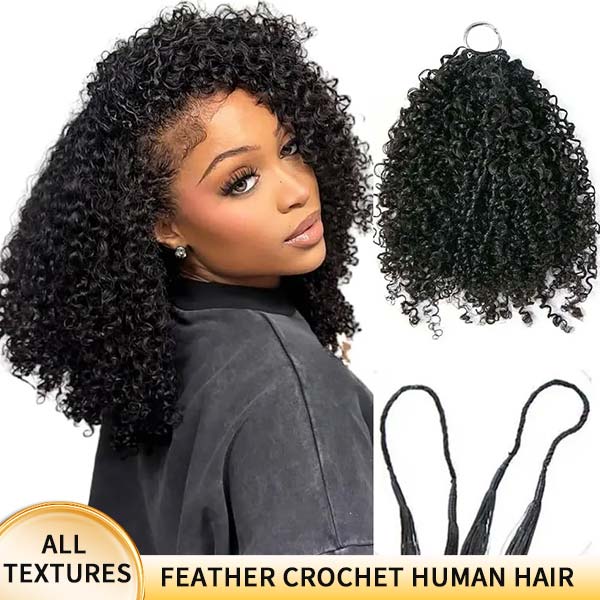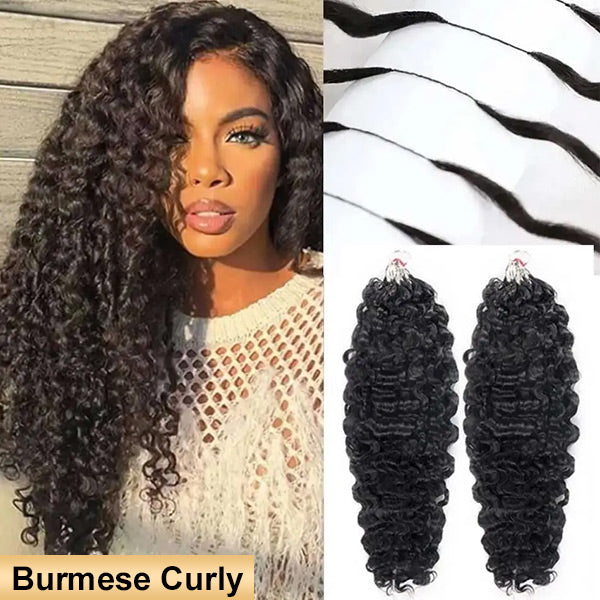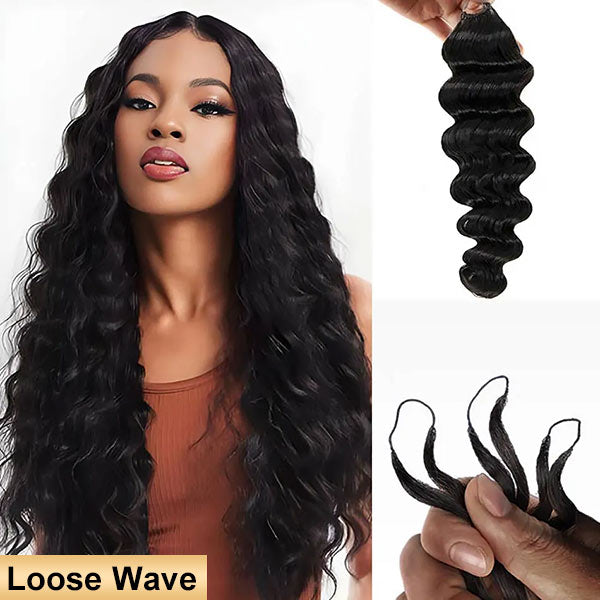Box braids have long been a beloved hairstyle, celebrated for their versatility, durability, and aesthetic appeal. They offer a protective styling option that shields natural hair from environmental damage while allowing for a wide range of creative expressions. However, a common question among those new to box braids is whether these braids can get wet.
The short answer is, "Absolutely!" However, proper care is essential. This guide will explore how water affects box braids, examining the differences in how synthetic and human hair braids react to water exposure. We’ll also provide tips and tricks to refresh your box braids after they've gotten wet. If you're interested in learning more, keep scrolling!

What Are Box Braids?
Box braids are individual three-strand braids that with square or triangle-shaped sections at the roots. They can be made with either synthetic hair or human hair, providing length, volume, and the opportunity to experiment with various colors and styles without altering your natural hair. Box braids are known for their protection of natural hair, neat, and uniform appearance, and long durability that can last several weeks with proper care.

Benefits of Box Braids
Box braids provide numerous benefits, including:
- Low Maintenance: Once installed, box braids require minimal daily upkeep.
- Protective Style: They protect natural hair from environmental damage and reduce the need for daily manipulation.
- Versatility: Box braids can be styled in numerous ways, offering endless possibilities for creativity. Click and explore various box braids styles in our previous post: 50 Chic Box Braids Hairstyles For Black Women.
- Longevity: With proper care, box braids can last from 4 to 8 weeks, making them a cost-effective styling option.
Can Box Braids Get Wet?
Yes, box braids can get wet. However, it's essential to understand how water interacts with both the braids and your natural hair underneath. While getting your box braids wet is not inherently damaging, it does require proper care to prevent potential issues.

Differences Between Synthetic and Human Hair Box Braids in Terms of Water Exposure
- Synthetic Hair: When synthetic hair gets wet, it tends to hold water longer, making the braids heavier and potentially uncomfortable. Additionally, synthetic hair may not dry as quickly as human hair, increasing the risk of mildew or unpleasant odors.
- Human Hair: Human hair extensions handle water better and dry more quickly than synthetic hair. They are less likely to become heavy when wet and are easier to manage in terms of post-wash styling.
Common Concerns and Misconceptions About Wetting Box Braids
One common misconception is that getting knotless box braids wet will immediately ruin them. While water exposure does necessitate careful handling, it won't necessarily damage your braids if you follow the right steps. Another concern is that washing box braids will cause them to frizz or unravel. However, with the proper technique, you can maintain your braids' neat appearance even after they get wet.
Effects of Water on Box Braids
Potential Issues: Frizz, Mildew, Loosening, and Heaviness
- Frizz: One of the most noticeable effects of water on box braids is frizz, especially if the braids are not dried properly. This can lead to a less polished look and can shorten the lifespan of your braids.
- Mildew: If box braids are not thoroughly dried after getting wet, they can develop mildew, which causes an unpleasant odor and potential scalp issues.
- Loosening: Repeated water exposure can cause the braids to loosen, especially at the roots, which can lead to a messy appearance and reduce the style's longevity.
- Heaviness: Wet box braids, particularly those made with synthetic hair, can become heavy, pulling on the scalp and causing discomfort.
How Water Affects the Scalp and Natural Hair Underneath the Braids?
Water can reach the natural hair and scalp beneath the braids, which can be beneficial or problematic depending on how it's managed. Proper hydration is essential for scalp health, but excessive moisture without proper drying can lead to issues like mildew, dandruff, and scalp irritation. It's crucial to strike a balance between keeping the scalp clean and ensuring it stays dry enough to avoid complications.
Impact of Frequent Wetting on the Longevity of Box Braids
Frequent wetting can shorten the lifespan of your box braids by causing frizz and loosening. If you swim regularly or live in a humid climate, you may need to refresh or redo your braids more often. However, with the right maintenance routine, you can minimize these effects and extend the duration of your style.
How to Properly Wash Box Braids?
Step-by-Step Guide to Washing Box Braids
Step 1: Prepare Your Braids: Before washing, gently detangle your braids using your fingers or a wide-tooth comb to remove any knots or debris.
Step 2: Dilute Shampoo: Mix a sulfate-free shampoo with water in an applicator bottle for easier application and to prevent product buildup.
Step 3: Apply Shampoo: Apply the diluted shampoo directly to your scalp, focusing on the roots. Use your fingertips to gently massage the scalp and lift any dirt or oils.
Step 4: Rinse Thoroughly: Rinse your scalp and braids thoroughly with lukewarm water, ensuring all shampoo is removed.
Step 5: Condition: Apply a lightweight conditioner to the length of your braids, avoiding the roots to prevent buildup. Let it sit for a few minutes before rinsing.
Step 6: Rinse Again: Rinse your braids thoroughly, making sure no conditioner remains.
Step 7: Dry: Squeeze out excess water from the braids using a microfiber towel or an old T-shirt, which helps to minimize frizz.

Recommended Products: Shampoos, Conditioners, and Oils
- Shampoos: Use sulfate-free and paraben-free shampoos to avoid stripping natural oils from your scalp and hair.
- Conditioners: Opt for lightweight, hydrating conditioners that won't weigh down your braids.
- Light Oils: Apply natural oils like jojoba, argan, or tea tree oil to keep your scalp moisturized and healthy.
Tips for Avoiding Common Pitfalls
- Avoid Excessive Product Use: Too much shampoo or conditioner can lead to buildup, which is harder to rinse out when your hair is braided.
- Be Gentle: Avoid vigorous scrubbing, as this can cause frizz and disrupt the neatness of your braids.

Drying Box Braids After Getting Wet
Methods for Drying Box Braids: Air Drying vs. Blow Drying
- Air Drying: This is the gentlest method and helps to prevent heat damage. After squeezing out excess water, let your braids air dry naturally. This method can take several hours, so plan accordingly.
- Blow Drying: If you need to dry your braids quickly, use a blow dryer on a low heat setting. Focus on the roots and move down the length of the braids. Always use a heat protectant spray to minimize damage.
Importance of Thorough Drying to Prevent Mildew and Scalp Issues
Ensuring that your braids are thoroughly dried is crucial to prevent mildew and scalp issues. Mildew can develop when moisture is trapped in the braids, leading to unpleasant odors and potential scalp problems. Thorough drying also helps to maintain the overall health of your natural hair and scalp.
Time-Saving Tips for Efficient Drying
- Use a Microfiber Towel: Microfiber towels absorb more water than regular towels, speeding up the drying process.
- Separate Braids: Spread your braids out while drying to allow air to circulate more effectively.
- Use a Hooded Dryer: If you have access to a hooded dryer, it can help to dry your braids more evenly and efficiently.

Swimming with Box Braids
Preparation Before Swimming: Protective Measures
- Wear a Swim Cap: A swim cap can help to minimize water exposure and protect your braids from chlorine and saltwater.
- Apply Leave-In Conditioner: Coat your braids with a leave-in conditioner before swimming to provide a protective barrier against chlorine and saltwater.
Post-Swim Care Routine: Rinsing, Washing, and Drying
- Rinse Immediately: After swimming, rinse your braids thoroughly with fresh water to remove any chlorine or salt.
- Wash Gently: Follow the washing steps outlined earlier to clean your braids and scalp.
- Dry Thoroughly: Ensure your braids are completely dry to prevent mildew and maintain their integrity.
Tips for Minimizing Damage from Chlorine and Saltwater
- Limit Exposure: Try to limit the time your braids are submerged in chlorinated or saltwater.
- Rinse Often: Rinse your braids frequently if you swim regularly to remove harmful chemicals and salt.
- Deep Condition: Deep condition your braids regularly to keep them hydrated and healthy.

Maintaining Box Braids in Humid or Rainy Weather
Protective Hairstyles and Accessories
- Use Hats or Scarves: Protect your braids from humidity and rain with stylish hats or scarves.
- Try Updos: High buns or ponytails can help to keep your braids neat and reduce exposure to humidity.
Daily Maintenance Tips to Keep Braids Looking Fresh
- Moisturize Regularly: Use a light oil or braid spray to keep your scalp and braids moisturized.
- Wrap Your Braids at Night: Use a silk or satin scarf to wrap your braids at night to prevent frizz and maintain their neatness.
Products to Combat Frizz and Maintain the Integrity of the Braids
- Anti-Frizz Sprays: Use anti-frizz sprays to keep your braids smooth and reduce frizz caused by humidity.
- Leave-In Conditioners: Lightweight leave-in conditioners can help to maintain moisture and reduce frizz.
FAQs About Getting Your Box Braids Wet
Q: Can Box Braids Be Worn While Exercising or Sweating?
A: Yes, box braids can be worn while exercising or sweating. It's essential to keep your scalp clean and dry by using a sweatband or headscarf during workouts. After exercising, allow your scalp and braids to dry thoroughly to prevent buildup and odor.
Q: How Often Should Box Braids Be Washed?
A: Box braids should be washed every 2-3 weeks to keep your scalp clean and free of buildup. However, the frequency may vary based on your lifestyle and how much you sweat or expose your braids to water.
Q: What to Do If Box Braids Get Wet Unexpectedly?
A: If your box braids get wet unexpectedly, dry them as soon as possible to prevent mildew and frizz. Use a microfiber towel to absorb excess water and let your braids air dry or use a blow dryer on a low heat setting.
Conclusion
In summary, box braids can indeed get wet, but proper care is essential to maintain their appearance and longevity. Understanding how to wash, dry, and protect your box braids from water exposure will help you enjoy this versatile hairstyle without compromising its integrity. Whether you're swimming, caught in the rain, or simply washing your hair, following the guidelines outlined in this article will ensure your box braids stay fresh and beautiful.
Explore the variety of box braided wigs available at mybraidedwig.com to enjoy the beauty and convenience of box braids without the commitment. Our collection includes various box braids styles, knotless box braids, criss-cross box braids, and other braided wig options to suit your preferences. Visit mybraidedwig.com today and discover your perfect braided wig!
Related Articles:
50 Chic Box Braids Hairstyles For Black Women
Why Do Black Women Wear Braided Wigs?
50 Stunning Knotless Braids Hairstyles You Need to Try!
























































